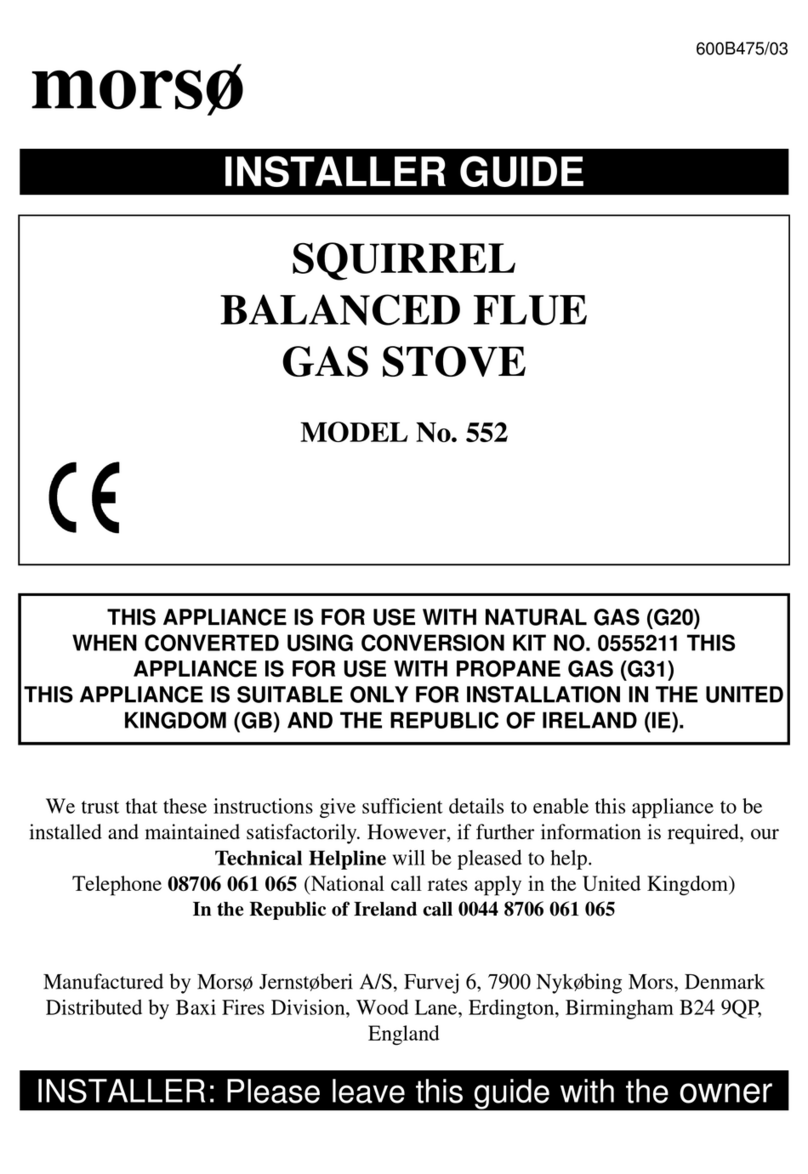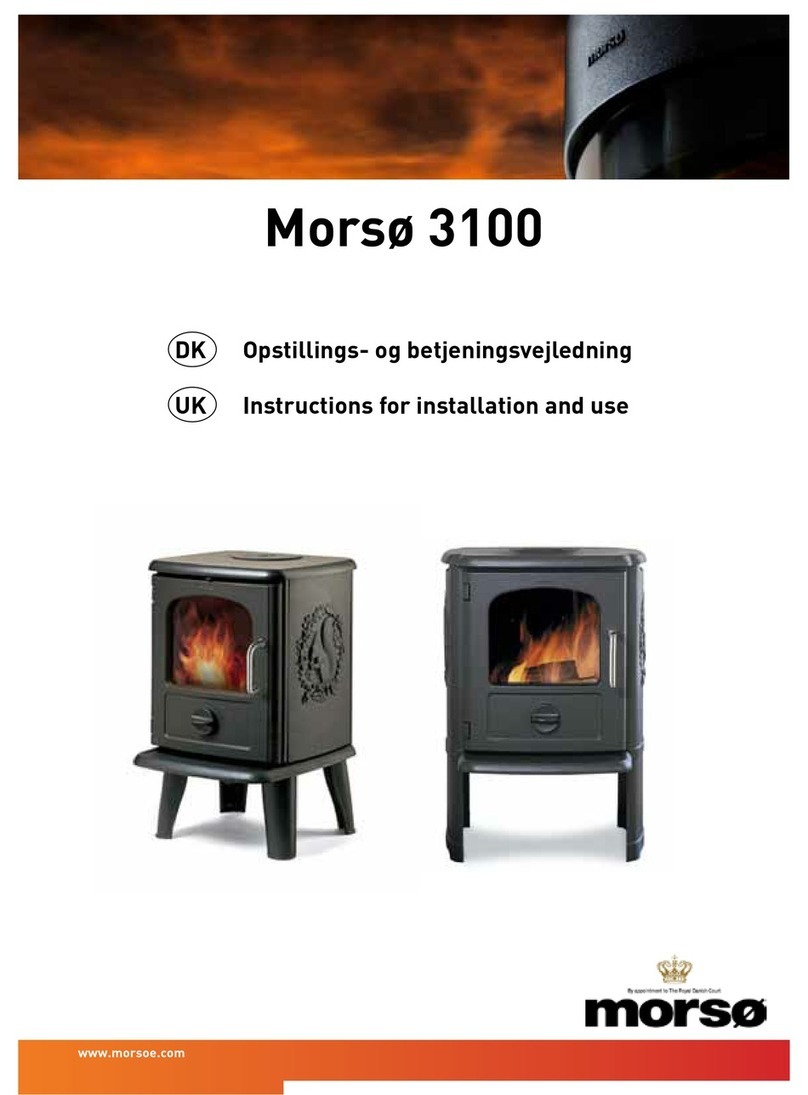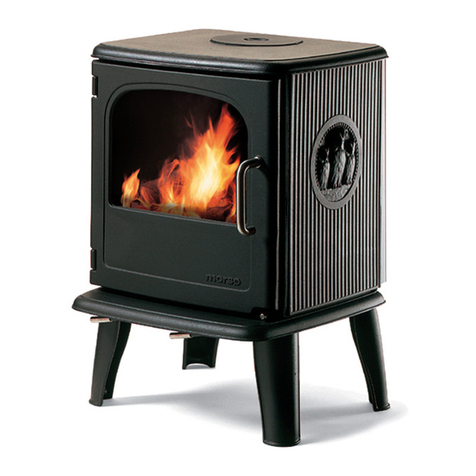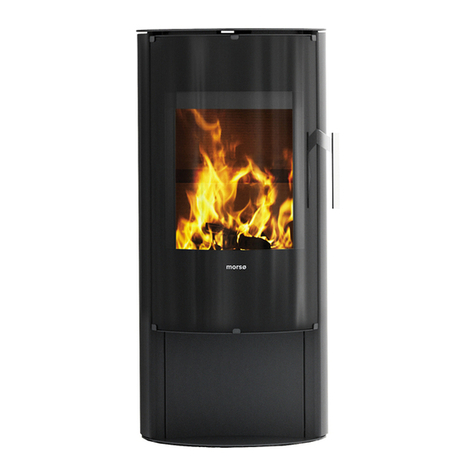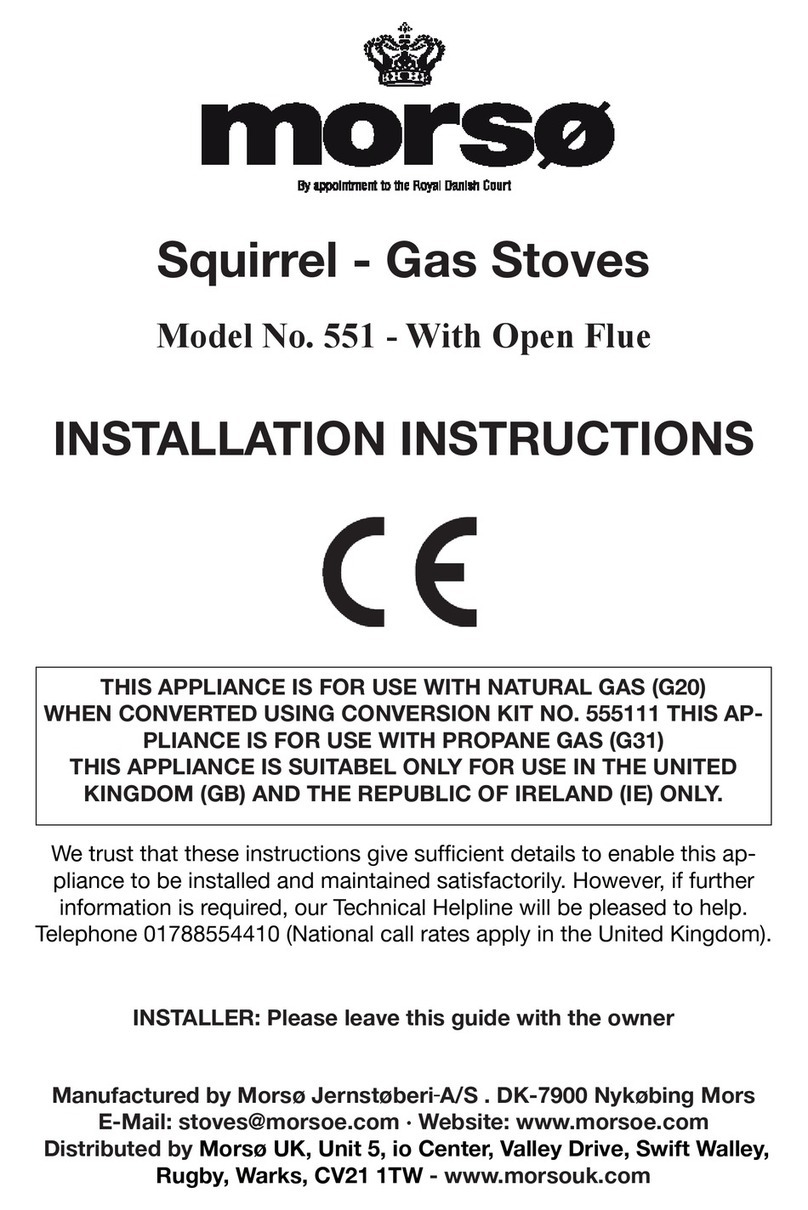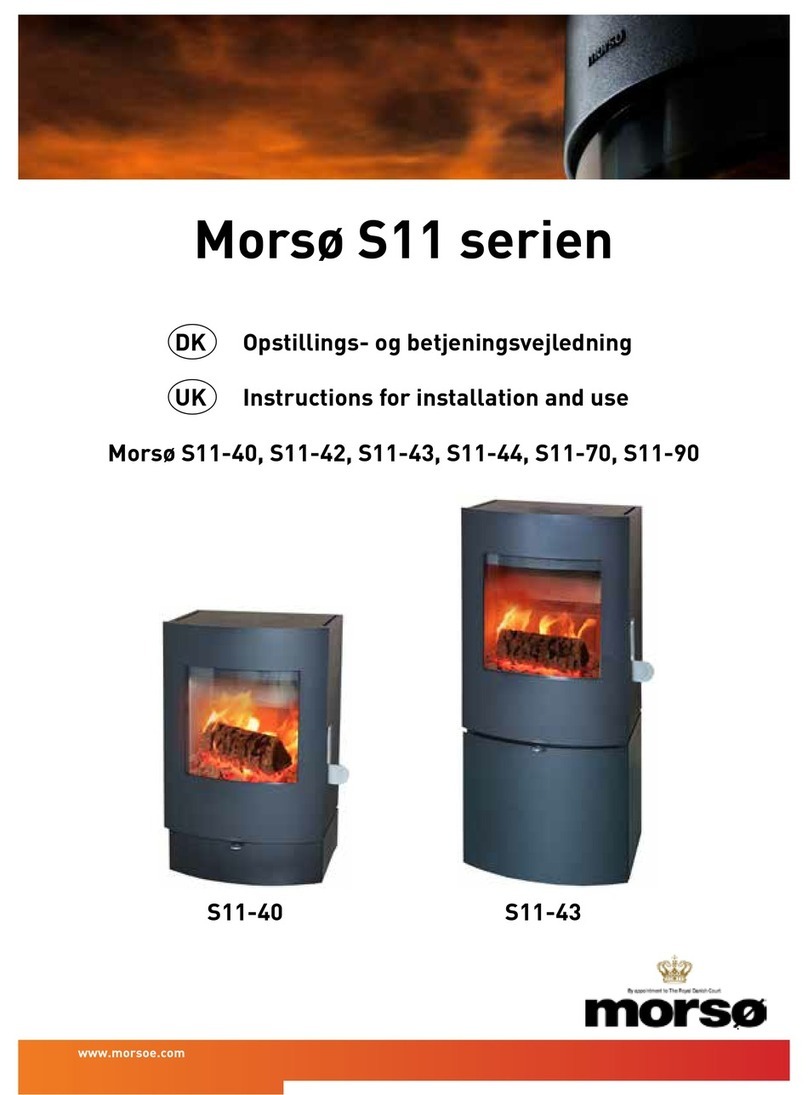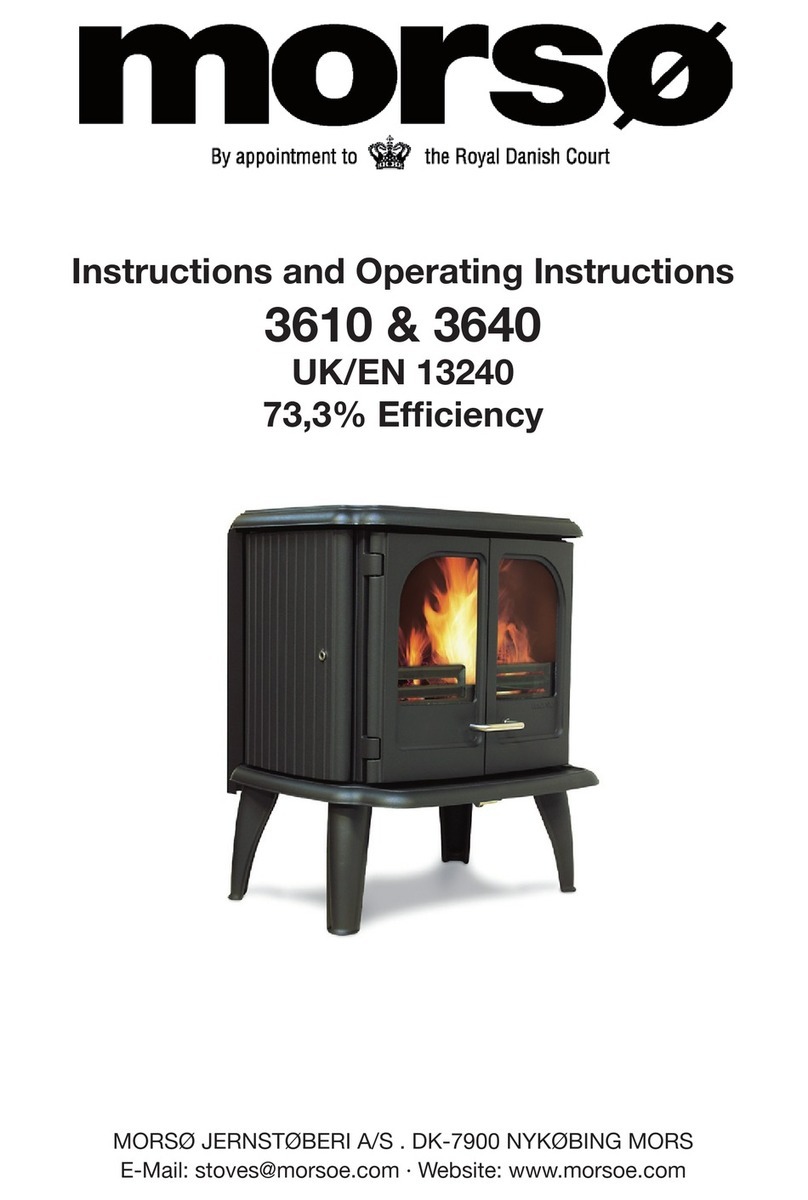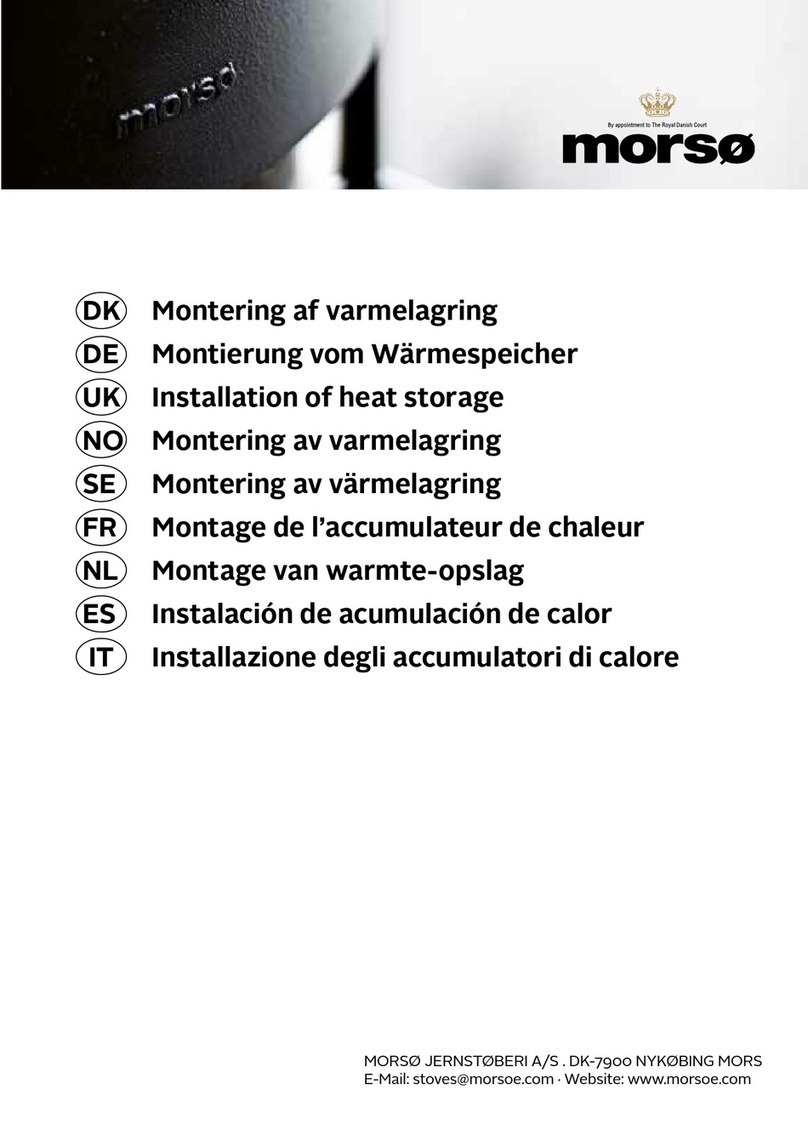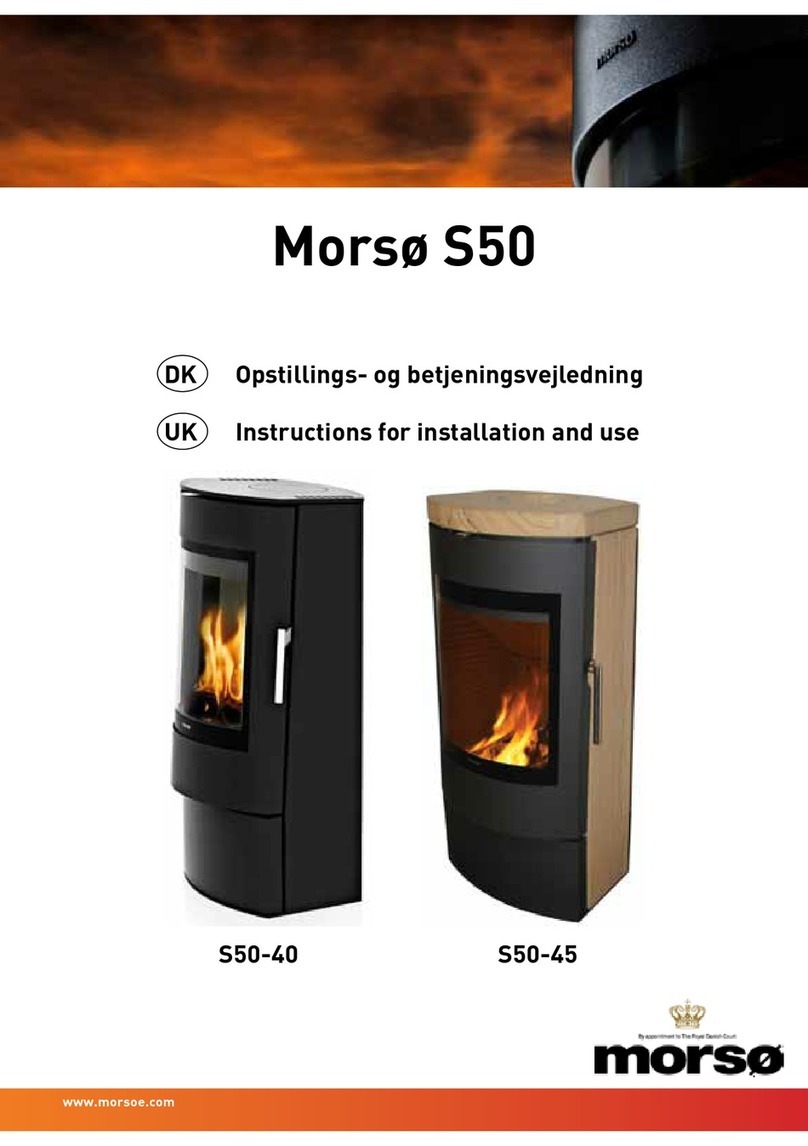LIVING WITH YOUR STOVE
Every fuel, chimney and condition of use is different. Only
experience will show which are the est settings for you.
HOW THE D 15 WORKS: The Morso DB15 is a 'down urn' stove
where the waste gases pass do n through the hot fire and into an
'after urn' cham er (A) at the ack where even smoke is urned
away. This system gives very clean com ustion and extremely
high efficiency on a wide range of fuels.
LIGHTING If lighting after a period of non-use, do check that the
flueways and chimney are completely clear. Empty the ashes if
need e. Place two or three firelighters close together, or screwed-
up paper covered with dry sticks, at the ack of the grate and light
them. When they are urning well
gently fill the fire with dry fuel.
Down urn stoves ignite very
quickly, ut they egin to urn at
the ack, so the full flame may not
e apparent for a few minutes.
FILLING: (C) Don't fill to the point
where fuel touches roof of the
stove.
CONTROL. Correctly installed
(see separate sheet) this stove
will control itself for minimum fuel
consumption.
The manual control on the top of
the door overrides the automatic
control. It can e helpfully used
when first lighting or refuelling, ut
keep it shut, or nearly so, in normal use.
The Thermostat Dial on the lower right of the stove controls a
device which senses the temperature of water in the oiler and
automatically allows air in to make the fire urn more or less
fiercely, so that water always leaves the oiler at a out 50ºC on
the lowest setting to a out 90ºC at the
highest. Once you have found the most
appropriate setting for your house - usually
a out midway - it shouldn't e necessary to
adjust it again. To adjust the house
temperature, adjust the radiator thermostats
(if fitted) or your central room thermostat.
These controls will then automatically limit or
allow the flow of water through the oiler,
which will adjust itself accordingly. Your fire
will die down or flare up and the central
heating pump go on or off as needed in response to the
temperature of rooms and water.
When you adjust the central controls, wait an hour or two for the
adjustment to ' ed in' - controls are deli erately made to react
slowly to prevent rapid on-off-on-off cycling.
EMPTYING ASHES. If you're urning only wood, ash need only e
emptied once it egins to overflow.
On the Multifuel model, using mineral fuels like anthracite, coal or
manufactured smokeless fuels, the ash must e removed efore it
uilds up to touch the underside of the grates, or it will severely
damage them. To empty the ash on multi-fuel models agitate the
fire ed y using the tool to operate the riddling mechanism on the
right-hand side. Use the ashpan tool to lift out the ashpan.
Remem er to let ash cool efore disposing in plastic sacks or
dust ins.
EXTENDED URNING Allow the fire to urn down to a low, hot
fire ed. Empty the ash, fully fill with hard fuel such as anthracite
and your stove can urn for up to twelve hours without attention.
KEEPING THE WINDOW CLEAN. Reduce the risk of staining y
using only very dry fuel. Severe stains can e removed when cold
with a domestic leach cleaner. DO NOT use proprietary solvent-
ased stove window cleaners. The window is not glass ut a
transparent ceramic, it may develop tiny hairline cracks, these are
harmless, and a characteristic of the toughest and material known.
OPENING THE DOOR This stove is designed to e operated only
with the door closed. Open the door very slowly to minimise fume
emission and prevent hot fuel falling out.
SUMMER SHUT DOWN: Before a long period of non-use, empty
fuel and ash and leave all the air controls open to allow ventilation
to reduce condensation.
FUELS
The Multifuel Morso DB15 is one of very few stoves which can
urn almost any solid fuel. The PureWood models can only urn
wood products such as logs or wood riquettes, with extraordinary
cleanliness and efficiency.
There is no 'perfect' fuel, so we strongly recommend that you try a
selection of fuels (or mixtures) to find which suits you est. Do
avoid dusty materials like sawdust, they can urn far to violently.
SMOKE CONTROL: In certain
areas special rules apply to
reduce smoke nuisance. Check
with your local authority.
WOOD only emits as much
car on to the atmosphere as the
tree took in when growing, so wood is considered the 'car on
neutral' fuel. When wood is cut down its cells are full of water.
Burning such wet or 'green' wood wastes heat in making steam
and produces flamma le, acidic tars which will cling to, and rapidly
damage, your stove and chimney. Split logs will typically take two
years to ecome reasona ly dry, round logs very much longer.
Cracks in the ends, a hollow sound when tapped and ark falling
away are all signs that a log may e ready for use. The fine, white
residue produced when wood urns is not ash, ut the remains of
cell walls which can urn if kept hot enough, so don't de-ash the
fire until a solutely necessary when using wood.
For est performance, and al ays for low smoke emission:
●Split logs lengthways for drying
●Use logs no igger than a out 100mm x 250mm
●Ensure logs are a solutely dry (less than 20% moisture)
●Fill the stove loosely, so air can circulate etween logs.
●Fill 'little and often'
●When first lighting, or reviving a fire from em ers, use only very
small, thin, dry, sticks.
●Keep a constant, deep, ed of charcoal and wood ash eneath
the urning logs. This may need several firings to uild up.
JOINERY WASTE Dry wood offcuts will urn well, ut don't expect
softwood waste to urn as cleanly or for as long as hardwood logs.
PEAT: Sod turf must e thoroughly dry.
LIGNITE or ROWN COAL is a natural mineral, etween peat
and coal. It lights easily and urns well, ut produces much ash.
ITUMINOUS COAL (Sold as 'Housecoal' or 'Polish') (does
NOT urn smokelessly, and is not permitted in smoke control
areas of the UK and RoI) is raw, natural coal containing a high
proportion of itumen. The DB15 is one of very few stoves which
can urn this fuel with high efficiency. But e aware that It makes
lots of tarry smoke and large volumes of flamma le gas which can
sometimes make it difficult to control.
ANTHRACITE is a natural hard, shiny form of coal. Slow to light, it
can urn for very long periods with great heat. Despite its high
price-per- ag it generally works out to e one of the cheapest of all
fuels. Use the 'small nuts' size.
COKE is coal from which the smoke has een removed.
Sometimes difficult to light, it urns very cleanly.
RIQUETTES Are compressed locks of fuel, generally a le to
urn for long periods and remarka le for their consistency.
'Homefire' and 'Phurnacite' are smokeless types while other
rands are made from lignite, peat or housecoal.
PETROLEUM COKE sold as 'Petcoke', 'Long each' and other
names, is an industrial reagent made from oil sometimes simply
sold as 'smokeless fuel' without any rand designation and
identifia le y a structure of tiny cohered eads. Although the
DB15 can urn this fuel safely, it WILL rapidly degrade interior
parts.
HOUSEHOLD WASTES Some plastics give off toxic fumes when
urned and remem er that atteries and aerosols explode! The
stove is not an incinerator, so only ever use the recommended
fuels and NEVER use liquid fuels in any form.
PRO LEMS?
Pro lems like those listed here are usually due to some difficulty
with the installation, chimney or fuels, so please check ack
3





